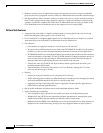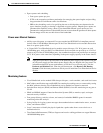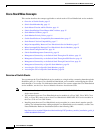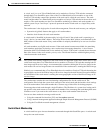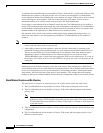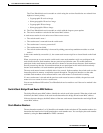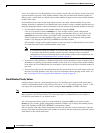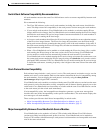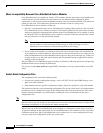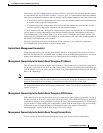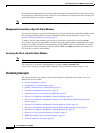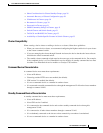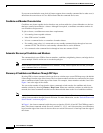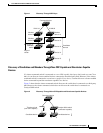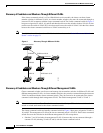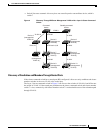
Cisco EtherSwitch Service Modules Feature Guide
Information About the Cisco EtherSwitch Service Modules
18
Cisco IOS Release 12.2(25)SEC
Minor Incompatibility Between Cisco EtherSwitch Service Modules
Cisco EtherSwitch service modules or Catalyst 3750 switches with the same major version number but
a different minor version number as the stack master are considered partially compatible. When
connected to a switch stack, partially compatible modules enter into version mismatch (VM) mode and
cannot join the stack. The stack master downloads the software version it is using to any
Cisco EtherSwitch service module in VM mode.
• If there is a stack member that is not in VM mode and is running software that can also run on the
Cisco EtherSwitch service module or Catalyst 3750 switch in VM mode, the stack master uses that
software to upgrade (or downgrade) the software on the Cisco EtherSwitch service module or switch
in VM mode. The Cisco EtherSwitch service module or switch in VM mode automatically reloads
and joins the stack as a fully functioning member.
Note The stack master does not automatically install the IP services image on a Cisco EtherSwitch
service module or switch running an IP base image or an IP base image on a Cisco
EtherSwitch service module or switch running an IP services image.
• If none of the stack members are running software that can be installed on the Cisco EtherSwitch
service module or switch in VM mode, the stack master scans the switch stack to see if there are any
other recommended actions. Recommended actions appear in the system messages log. If there are
no other actions to try, the stack master displays the recommended action to upgrade the software
running on the switch stack.
The port LEDs on Cisco EtherSwitch service modules or switches in VM mode remain off, and pressing
the Mode button does not change the LED mode.
You can also use the show switch privileged EXEC command to see if any stack members are in VM
mode.
Switch Stack Configuration Files
The configuration files record the following items:
• System-level (global) configuration settings—such as IP, STP, VLAN, and SNMP settings—that
apply to all stack members
• Stack member interface-specific configuration settings, which are specific for each stack member
The stack master has the saved and running configuration files for the switch stack. All stack members
periodically receive synchronized copies of the configuration files from the stack master. If the stack
master becomes unavailable, any stack member assuming the role of stack master has the latest
configuration files.
Note We recommend that all stack members have Cisco IOS Release 12.1(14)EA1 or later installed to ensure
that the interface-specific settings of the stack master are saved in case the stack master is replaced and
the running configuration is not saved to the startup configuration.
When a new, out-of-box Cisco EtherSwitch service module or switch joins a switch stack, it uses the
system-level settings of that switch stack. If a Cisco EtherSwitch service module or switch is moved to
a different switch stack, that Cisco EtherSwitch service module loses its saved configuration file and
uses the system-level configuration of the new switch stack.



